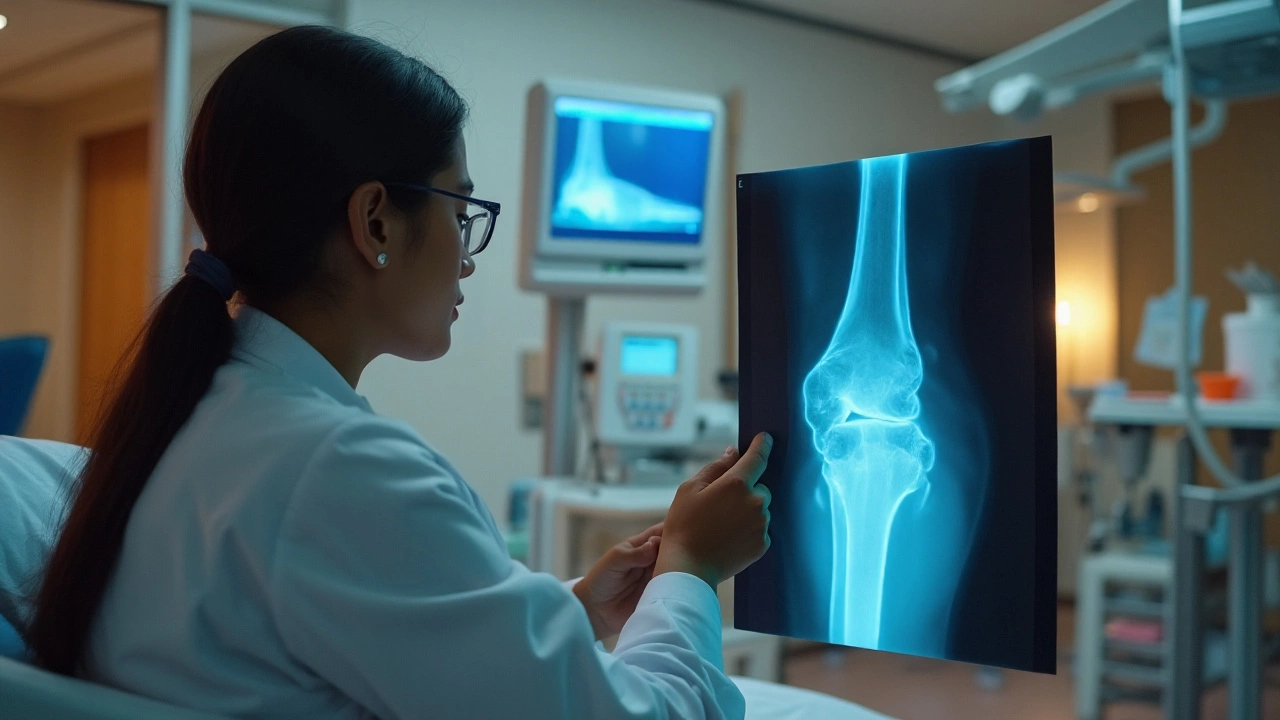When your body decides to act up, it often hits you where it hurts most: the bones, the joints, the muscles. And that's where orthopedics steps in. It's the right arm of the medical world, dedicated to making sure you can move without wincing.
Orthopedic care isn't just about surgery, though that's a big part of it. It's a full-spectrum approach that looks at how to keep your body's framework in the best shape possible. Whether it's through a gentle physical therapy session or a complex surgical procedure, orthopedics aims to restore your body’s well-being.
In understanding orthopedics, it’s helpful to know about the range of conditions covered, the latest in diagnosis, and the innovative treatments available today. We'll delve into all these aspects, helping you grasp the essentials of maintaining your musculoskeletal health.
- Definition and Scope of Orthopedics
- Common Orthopedic Conditions
- Diagnosis Methods
- Treatment Options
- Preventive Measures
- Orthopedic Innovations
Definition and Scope of Orthopedics
Orthopedics is a branch of medicine that dives deep into the intricate world of bones, joints, and muscles, focusing on improving life's quality through healing and repair. From sports injuries to age-related issues, orthopedic care covers a wide spectrum of conditions that can affect anyone at any age. This medical discipline not only deals with the tangible, like fractured bones, but also deciphering the anomalies that lie beneath the surface, ensuring that every movement you make is pain-free and fluid.
At its core, orthopedics is about restoring and preserving physical function. Doctors in this field are equipped with the knowledge to tackle congenital anomalies as well as disorders arising from modern lifestyles. They employ a mixture of treatments that range from hands-on physical therapy to technologically advanced surgeries. Such diversity in methodology speaks to the comprehensive scope of orthopedics, which embraces both traditional practices and innovative approaches to patient care.
The history of orthopedics traces back to ancient civilizations where healers used rudimentary methods to set bones and soothe aching muscles. Fast forward to today, where orthopedic specialists have an arsenal of tools at their disposal like MRI machines and robotic-assisted surgeries to diagnose and treat conditions effectively. According to a study published in the Journal of Bone and Joint Surgery, advancements in minimally invasive surgical techniques have shortened recovery times significantly, benefiting patients with quicker return to daily activities.
"The practice of orthopedics holds a unique position in healthcare, bridging the gap between pain and motion, offering life back to those it treats," says Dr. Henry Wilson, a renowned orthopedic surgeon.
The breadth of this field extends beyond treatment as it encompasses preventative measures too, making it a vital part of sports and exercise sciences. Regular screenings and interventions can prevent severe conditions down the road, highlighting the importance of orthopedics in day-to-day wellness. By understanding movement mechanics and body stress responses, orthopedic specialists provide guidance to athletes and desk workers alike, ensuring longevity in joint and muscular health.
Common Orthopedic Conditions
When we think about orthopedic care, it's easy to picture surgeons in scrubs, keen to fix a broken bone or a dislocated joint. But the world of orthopedic medicine is vast, encompassing a whole host of conditions that affect our movement and day-to-day life. From sprains, strains, and bursitis to more serious ailments like arthritis, osteoporosis, and spinal deformities, the list is extensive. These conditions don't just strike athletes; everyone from children to the elderly can find themselves in need of orthopedic attention. In fact, statistics indicate that musculoskeletal disorders are the second leading cause of disability globally.
One of the most pervasive issues is arthritis, which comes in over a hundred different types, with osteoarthritis and rheumatoid arthritis being the most common. A staggering number of people—approximately 1 in 6 globally—are affected by arthritis, and it can significantly impair one's quality of life. Osteoarthritis involves the degeneration of joint cartilage, leading to pain and stiffness, usually in the hands, knees, hips, or spine. Rheumatoid arthritis, an autoimmune disorder, causes inflammation in the joints, resulting in painful swelling that can eventually lead to joint deformity. Effective management of arthritis often involves a combination of medication, physical therapy, and sometimes surgery.
"Arthritis and related conditions remain a significant public health burden," states the World Health Organization. "Efforts to prevent such conditions and improve treatment options are paramount."
Another condition worth mentioning is osteoporosis, commonly known as the "silent disease" because it progresses without symptoms until a fracture occurs. It is characterized by weak and brittle bones, which makes patients prone to fractures even with minor falls or, in severe cases, bending over. Women, especially post-menopausal, are at greater risk. Regular check-ups and bone density tests are vital for early detection, and treatment includes medications, a diet rich in calcium and vitamin D, and lifestyle changes such as weight-bearing exercises.
In addition to these, scoliosis is a common yet often overlooked orthopedic condition that involves a sideways curvature of the spine. It often appears during a child’s growth spurt before puberty and can range from mild to severe cases. For most, scoliosis is a condition that may only require regular monitoring, but for some, it may demand surgery to restore proper spinal alignment. Early detection can be crucial in managing scoliosis effectively, often incorporating bracing strategies alongside physical therapy.
Not to forget are acute injuries like fractures and dislocations that often require immediate attention. When we talk about fractures, we're essentially referring to broken bones caused by accidents or, in some cases, repetitive stress over time. Dislocations occur when the bones in a joint become displaced. Immediate care in these cases is essential to ensure proper healing and minimize long-term complications. Orthopedic physicians may use a range of splints, casts, or surgical interventions to correct these injuries.
With all the orthopedic conditions, prevention, and awareness play a crucial role. Regular exercise, a healthy diet, and weight management can go a long way in preventing orthopedic problems. Also, be sure to wear protective gear when engaging in sports or activities prone to injuries. If you catch discomfort or find movement becoming difficult, reaching out to an orthopedic specialist promptly can help manage conditions before they escalate.

Diagnosis Methods
It’s a common scenario: a sudden twinge of pain, and before you know it, you're in the orthopedic clinic, seeking answers. The first step on this path is always the diagnosis – a detailed assessment to pinpoint the root of your discomfort. Modern orthopedic care relies on a sophisticated blend of technology and hands-on expertise to uncover what’s gone awry. Physicians start with a thorough medical history review and a physical exam. This initial step sets the stage for further investigation, as the right questions can often unearth clues pointing to the core of the issue.
Now, let's dive into what happens next. Imagine entering a world of advanced imaging technology. X-rays often lead the way, revealing fractures or dislocations with remarkable clarity. They're followed closely by MRIs, the detectives of the musculoskeletal world, which can show soft tissue injuries that aren't visible on an X-ray. Then there’s the CT scan, a technique that offers a three-dimensional view, bringing life to the hidden complexities inside our bodies. Often, these technologies work together, combining two or more methods to ensure nothing slips through the cracks.
But technology doesn’t work alone. It's guided by the skilled hands and seasoned eyes of orthopedic specialists who interpret the images with an expertise honed over years. There’s an art to balancing technology with intuition. Sometimes, these experts will also use diagnostic tests like bone scans or ultrasounds, especially when dealing with specific injuries or conditions. This accurate interpretation forms the backbone of effective orthopedic treatments.
Each diagnostic method has its place. For example, bone scans are invaluable for detecting hidden stress fractures or infections when other methods fall short. Ultrasound, meanwhile, is often used for real-time assessment of tendon issues or guiding procedures like injections. In these dynamic sessions, clinicians gain insights that might otherwise be hidden, unlocking the knowledge needed to chart the best course of treatment.
Role of Tests and Assessments
But what about the areas where imaging doesn't offer definitive answers? That's where diagnostic tests come in. Blood tests might reveal inflammatory markers, hinting at conditions like rheumatoid arthritis. Physical tests, often conducted by a physiotherapist, can assess range of motion and strength, helping to build a broader picture of the issue at hand. These tests are crucial in ensuring that every aspect of the problem is understood.Each layer of diagnostic precision reinforces the foundation for effective bone health management. The importance of a comprehensive diagnosis cannot be understated. It empowers both the physician and the patient, allowing for personalized treatment plans that address not just symptoms, but their root cause as well.
"In the realm of orthopedics, diagnostic accuracy is not just a step in the process; it's the compass that guides every subsequent decision," notes Dr. Emily Wright, a notable orthopedic specialist.With diagnosis as their guide, orthopedic professionals can craft strategies that range from conservative therapies to surgical interventions, ensuring each patient receives care that aligns with their unique situation.
Treatment Options
When it comes to orthopedic treatments, the options are wider and more advanced than you might imagine. Long gone are the days when surgery was the only answer to every bone and joint issue. Today, orthopedic healthcare professionals offer a plethora of treatments tailored to specific conditions and individual needs. The evolution in this field has led to a more nuanced approach to managing musculoskeletal problems.
Non-surgical interventions often spearhead treatment plans. Physical therapy is commonly recommended and serves as a cornerstone for restoring mobility and strength. Therapists employ exercises that are specifically designed to target affected areas, improve flexibility, and reduce pain. This often goes hand-in-hand with occupational therapy, focusing on helping patients return to their daily routines with greater ease and less discomfort. Moreover, lifestyle adjustments and nutritional advice are given to support healing and prevent future complications.
Orthopedics often deal with joint problems, so joint injections may be considered for pain relief and inflammation reduction. These can include corticosteroid injections or hyaluronic acid treatments, which provide lubrication much like oiling a squeaky door hinge, allowing for smoother joint motion. For more systemic issues like osteoporosis, medications may be prescribed to strengthen bones and prevent fractures. These pharmacological interventions are stepping stones toward better bone health and improved patient outcomes.
When these measures are insufficient, surgical procedures become a viable option. From arthroscopy, a minimally invasive surgery to examine and treat joints, to full joint replacements such as hips or knees, the surgical spectrum is vast and precise. Surgeons today use cutting-edge technology and techniques to ensure the highest level of accuracy and effectiveness. Robotics-assisted surgeries have gained traction, offering improved alignment and faster recovery times for patients.
"Modern orthopedic surgery is akin to engineering on a tiny, delicate scale," says Dr. Marina Wong, a renowned orthopedic surgeon. "Each procedure is carefully planned, taking into account the intricate structure of the human body.”
Sometimes, a combination of treatments is employed to tackle the stubborn issues. One might follow surgery with intensive rehabilitation programs, ensuring the best opportunity for complete recovery. Interestingly, many specialists now incorporate alternative therapies such as acupuncture or chiropractic care as complementary treatments. These alternative avenues can assist with pain management and enhance traditional medical treatments, providing a holistic approach to healing. As orthopedic innovations continue to evolve, so too do the treatment options available to patients. Regular updates and insights into the latest developments are crucial for anyone involved in this field, whether they are health professionals or those seeking the best solutions for their conditions. The dynamic nature of orthopedic treatment ensures that patients have access to the most effective care tailored to their unique needs, paving the way for healthier, more active lives.

Preventive Measures
When it comes to preserving bone and joint health, preventive measures are the backbone of orthopedic care. While addressing injuries and conditions is crucial, it's far better to keep them from happening in the first place. One vital aspect is maintaining a balanced diet rich in calcium and vitamin D, essential nutrients that support bone density and strength. Regular exercise is equally important, helping improve muscle tone and joint flexibility, which in turn reduces the risk of falls or other injuries. Not all exercise routines, however, are created equal. Lower impact workouts like walking, swimming, or cycling are often recommended to minimize stress on the joints while still building muscle.
It's also important to wear appropriate footwear that provides good support and cushioning, particularly if you’re prone to spending long hours standing. This simple measure can remarkably cut down on the wear and tear of joints like those in your knees and hips. An often neglected part of preventive care is awareness: being mindful of posture, especially during repetitive tasks, can prevent chronic conditions from developing over time. Workspaces set up ergonomically, with chairs and desks adjusted to one's needs, are simple yet effective strategies for maintaining proper body alignment.
Routine Check-ups
Regular check-ups with a trusted orthopedic specialist can't be stressed enough. These sessions provide an opportunity to catch potential issues before they fully form, allowing for preventive orthopedic care through personalized advice. Professionals can offer tailored exercises and recommend lifestyle changes. As noted by a reputable health source, "An ounce of prevention is worth a pound of cure," highlighting the immense benefits of staying ahead of problems.
Understanding Potential Risk Factors
Another critical part of prevention is understanding one's limitations and risk factors. History of family bone issues, early signs of arthritis, or previous injuries can skyrocket one's risk of developing orthopedic problems. If you're aware that your lineage carries a genetic condition likely to affect bone health, it becomes all the more important to take preventive steps proactively. This is particularly crucial for athletes and individuals engaged in physically demanding occupations, where repetitive stress and impact can pose significant threats to musculoskeletal health if not managed thoughtfully.
Preventive Strategies for the Elderly
For the elderly, preventive strategies might also include fall prevention measures such as installing handrails in bathrooms, using slip-resistant mats, and ensuring well-lit walkways throughout the home. It’s paramount to create a safe living environment that minimizes the risk of bone fractures which can unfortunately contribute to a rapid decline in the health of seniors. Regular screenings for osteoporosis and bone density tests provide useful insights into one’s bone health status, ensuring interventions are timely and accurate.
Orthopedic Innovations
In recent years, the field of orthopedic care has witnessed groundbreaking innovations that have revolutionized how medical professionals approach treatment. These advancements aren't just about doing things better; they're about doing them in previously unimaginable ways. Take, for example, 3D printing technology, which has allowed for the creation of bespoke implants tailored to each patient's unique anatomical needs. This custom fit not only enhances the success rate of surgeries but also significantly reduces recovery time. Patients can now enjoy a life closer to normal much sooner than they could a decade ago.
Another remarkable advancement is the use of robotics in surgery. Robotic technology provides a precision that human hands alone cannot achieve, allowing for minimally invasive procedures with heightened accuracy. This reduced invasion of body tissue leads to less post-operative pain and quicker healing. Surgeries that once left large scars and required lengthy hospital stays are now transforming into outpatient procedures. In fact, according to a study by the American Academy of Orthopaedic Surgeons, robotic-assisted surgeries reduce complications by up to 50%, a statistic that's hard to ignore.
Biological innovations have also made significant strides. Stem cell therapy and tissue engineering open doors to regenerating damaged tissue rather than replacing it. Harnessing the body's own repair mechanisms could mean a future where joint replacements become less common, replaced by therapies that restore rather than replace. This potential shift in treatment paradigms marks a significant turn towards less invasive and more continuously effective treatments.
Integrative and Holistic Approaches
An often overlooked yet vital aspect of modern orthopedic treatments is the integrative approach that many practitioners now adopt. Blending conventional methods with complementary therapies like acupuncture, chiropractic adjustments, and personalised physical therapy regimens, holistic practices strive to treat the patient comprehensively. This approach is grounded in the belief that the body functions optimally when all its systems are tuned and synched. A research paper from the British Journal of Sports Medicine highlighted that integrative care models often lead to better patient satisfaction and outcomes.
Last but far from least, digital health technologies have become a cornerstone in managing and diagnosing joint disorders. From wearable devices that track movement and provide real-time data to remote consultations that bring expert advice to rural areas, technology is making healthcare more accessible. Virtual reality (VR) simulations for rehabilitation can make physiotherapy exercises engaging, increasing compliance and effectiveness. These tools empower patients, making them active participants in their recovery journey.
"The future of bone health lies at the intersection of innovation and compassion," says Dr. Emily Stone, a prominent figure in orthopedic research. "When we innovate with empathy, the results are transformative."
Each of these orthopedic innovations not only improves the effectiveness of treatment but also augments the patient's experience, ensuring that healthcare isn't just about extending life, but enriching it. As technology marches forward, the realm of orthopedics continues to evolve, promising brighter, pain-free days for those affected by musculoskeletal issues. It's an exciting time for both patients and practitioners, who are embracing changes that truly make a difference.
